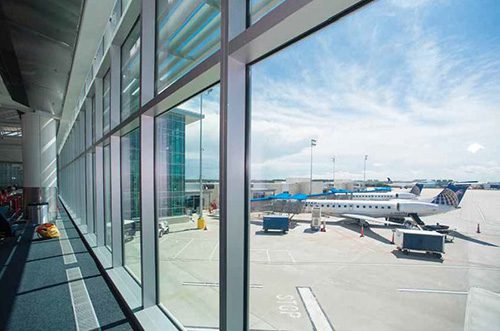 The Houston Airport System and United Airlines have taken their public-private partnership to a whole new level with construction of a new concourse at George Bush Intercontinental Airport (IAH). At a total cost of nearly $150 million, the South Concourse of Terminal B was completed in two distinct, yet interrelated, projects: United funded the $97 million vertical structure; and the Houston Airport System funded its $52 million apron, ramp and utilities infrastructure work. Together, the projects create a 30-gate facility that allows United to consolidate the majority of its regional jet operations and upgrade customer amenities.
The Houston Airport System and United Airlines have taken their public-private partnership to a whole new level with construction of a new concourse at George Bush Intercontinental Airport (IAH). At a total cost of nearly $150 million, the South Concourse of Terminal B was completed in two distinct, yet interrelated, projects: United funded the $97 million vertical structure; and the Houston Airport System funded its $52 million apron, ramp and utilities infrastructure work. Together, the projects create a 30-gate facility that allows United to consolidate the majority of its regional jet operations and upgrade customer amenities.
The new South Concourse is also the first phase of a three-phase Terminal B redevelopment that is projected to span the next seven to 10 years and cost $1 billion. Terminal B will now function as the primary facility at IAH for United Express flights operated by ExpressJet, SkyWest, Trans States and Shuttle America. Together, United’s regional partners operate more than 300 flights a day out of IAH. The new concourse accommodates regional aircraft with capacities up to 76 seats.
With extensive connecting traffic, IAH is a “premier international gateway and a key hub in United’s network,” says Jim Compton, United’s vice chairman and chief revenue officer.
In contrast, the previous concourse, built in 1969, was outdated and inefficient, says Lance Lyttle, IAH’s chief operating officer. “With only 19 gates, we had limitations on the number of RJs (regional jets) we could fit in there,” Lyttle elaborates. “Now, United is able to put in all of their RJ operations on the south side and consequently manage its fleet much more efficiently.”
Listening to the Customer
The South Concourse project is United’s first new terminal facility since merging with Continental Airlines in 2010. As such, the IAH facility will serve as a prototype for future construction/renovation of United terminals.
“Terminal B South was built with more of the features our customers tell us they value: more seats, more space, more concessions, more power outlets and Wi-Fi,” details Kate Gebo, United’s vice president of corporate real estate.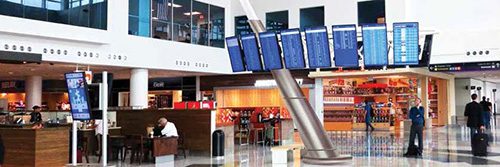
The 225,000-square-foot facility is nearly four times the size of the previous concourse and features a single, open holdroom that serves all 30 gates. The terminal also includes 17 food/beverage and retail options spread over 15,000 square feet — 500% more concessions space than the former facility.
To reach the holdroom, passengers traverse a 90-foot-wide pedestrian bridge over the main roadway that circles the central terminal facility. With 15 concessionaires on each side of the bridge, passengers are treated to a “mall-like experience,” says Cheryl Gajeske, principal of PGAL, the project’s architect of record. There are also two concessions inside the 1,056-seat holdroom.
Several restaurants specializing in Texas cuisine are making their airport debut, including 3rd Bar Oyster & Eating House, the creation of Chef Bryan Caswell and Food and Beverage Director Bill Floyd. In 2009, Caswell was named one of Food & Wine magazine’s Top Ten Best New Chefs; and in 2008, Bon Appetit named Reef, Caswell and Floyd’s midtown Houston location, the best seafood restaurant in the United States.
|
factsfigures
Project: New Concourse |
Other airport firsts include Barcuterie, Bullritos, Texas icon Whataburger, and Chef Johnny Hernandez’s The Fruteria.
Shopping options include an iStore Boutique (the first airport retailer authorized to sell Apple products), Relay, Brookstone, The Body Shop, Ice Currency Exchange, Johnston & Murphy, Natalie’s Candy Jar and Nuance Duty Free.
“The food court has been jammed with people since the new concourse opened,” Gajeske reports. “Travelers are treated with a shopping experience before they even get to the holdroom.”
“Everything is visible from the holdroom,”
Gebo adds. “The line of sight was very important to us. If customers can’t see it, they won’t visit it.”
The bridge opens into the open-design holdroom, which features a 40-foot floor-to-ceiling expanse at its highest point and a 28-foot glass wall with dramatic views of the tarmac and Houston skyline.
“People walk in, stop, look up and go ‘wow,’” Gebo relates.
“Then, they kind of get involved with the space. People don’t just sit in one place; they move around, interact with the space. It really has a different feel and removes a lot of travel stress. It’s all about letting people relax before they get on their flight.”
Large screens allow travelers to track flight information while remaining seated. “People don’t have to get up to ask an agent, ‘Where am I on the standby list?’ or ‘What are the amenities on this flight?’ Gajeske explains. “It’s all displayed where they are sitting; so it prevents them from getting nervous and anxious, then crowding the boarding area for answers.”
Service centers were also designed to facilitate self-service, because that’s what customers have said they want, Gebo reports. Kiosks allow travelers to adjust their own itineraries if, for example, a flight gets cancelled. “In many instances, they are able to resolve travel issues at a kiosk without having to see an agent,” she explains. 
With its large, new consolidated holdroom, United focused particular attention on seating arrangements, selecting various configurations to suit various customer categories. “We don’t have just the traditional bench seating,” Gebo explains. “We also have cluster seating for business travelers who like to have a table between them and other travelers. We put in bar seating similar to the Apple iBar concept for our younger travelers who love to plug in while sitting at a bar-like table. We’ve tried to provide something for everyone. (Free) Wi-Fi is available throughout the facility, and over 50% of seats have outlets for travelers to plug in and charge their devices.”
At boarding time, passengers descend escalators to the ground level and enter a walkway to their flights. Swing Gate Ramps, by Keith Consolidated Industries, were designed with stop marks at different locations to operate in multiple locations and accommodate various regional aircraft (ERJ-145, CRJ-200 and CRJ-700).
Continuing the airline’s move toward self-service efficiencies, United planned to test self-boarding gates in Terminal B by the end of 2013.
Keeping it Green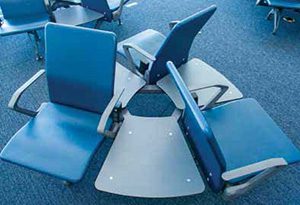
In addition to engineering the South Concourse to be open and customer-friendly, designers also focused on making it sustainable. The facility is projected to consume 19% less energy than a conventional building, and team members expect it to earn silver certification for Leadership in Energy and Environmental Design.
“The ‘green’ aspect is very important to us,” emphasizes Gebo. “The building features a cool roof system, so it actually reflects 76 percent of the heat gain from sunlight.”
The holdroom’s 28-foot, high-efficiency glass wall uses exterior louvers and a roof overhang to shade the glass from direct sunlight. Inside, light fixtures with daylight harvesting sensors turn lights off and on based on the amount of natural light present in the space. High-efficiency HVAC equipment is zoned to save energy and maximize utilization.
The project is also on track to recycle more than 95% of its construction waste. “We had to demolish hundreds of tons of existing 40- to 50-year-old buildings to make room for this project. Everything was sorted and tracked to ensure the highest repurposing of materials,” reports Jim Clemens, executive vice president and general manager of Skanska's Aviation Center of Excellence, the project’s construction manager.
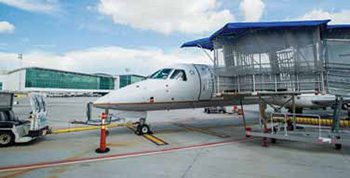 Two Projects, One Goal
Two Projects, One Goal
The United team began vertical construction on the concourse facility in January 2012; and the Houston Airport System team broke ground on the infrastructure work outside the terminal envelope later that year in May. With two separate teams, each working on its own project, airport officials stressed the importance of focusing on one goal: building a modern terminal facility with as few disruptions to customer service and flight operations as possible.
Lyttle describes the challenge: “Even though we had two different designers and two different general contractors, we had to manage the two projects as one project. The first thing we had to do was to establish guiding principles that would enable our two teams to function as one team. If United failed, we failed; if we failed, United failed. The outcome had to be a win-win.”
To facilitate workflow, major players from both projects met weekly to discuss and coordinate activities.
“Effectively, the project had two owners, two designers and two contractors, all of whom were converging on a relatively small piece of real estate with active aircraft operations,” relates Harold vandeMeerakker, Aviation Group Manager for Atkins, the design consultant on the outside infrastructure and flatwork. “Project coordination was complex and constantly changing, but the efforts of all stakeholders allowed changes to the project to be incorporated smoothly.”
“The logistics on this project were incredibly demanding,” says Clemens. “We took a multi-phase approach in order to take as few gates out of service as possible, while building a very large and complex structure in the midst of airport operations. Aircraft were moving in and out within 15 feet of our fence line.”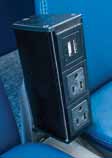
Their efforts, however, bore fruit. The building became operational within 12 to 13 months, Clemens proudly reports. At the peak of construction activity, more than 275 workers from about 70 subcontractors operated simultaneously, 24/7.
Clemens describes the multi-company group that pushed the project forward as “the most integrated team” with which he has ever been involved. “All of the stakeholders on this project team left their egos and individual agendas at the door,” he explains. “We worked through challenges and developed solutions in a comprehensive and collaborative manner that, I believe, sets the standard as to how an integrated project should be delivered in an aviation environment.”
“The successful completion of this project is a credit to the entire team,” agrees vandeMeerakker. “As aviation engineers, we live for this kind of project and its challenges.”
One Down, Two to Go
With the last 15 gates of the new South Concourse slated to open in January, attention was shifting to the remaining portions of the $1 billion Terminal B redevelopment plan. During Phase 2, crews will reconstruct the North Concourse; in Phase 3, they’ll focus on the Central Terminal area.
According to Gebo, design work on Phase 2 is scheduled to begin later this year. In the meantime, United plans to make cosmetic improvements to “diminish the stark differences between the new facility and other areas of the terminal.”
|
Sound Design
Airport officials consequently contracted Houston-based HFP Acoustical Consultants to design the audio system for the new Terminal B South Concourse. With 28,000 square feet of floor space and ceilings soaring up to 40 feet, HFP focused on high speech intelligibility and excellent coverage. The goal was to help airport guests hear and understand flight announcements and other important information — no matter where they are sitting or walking in the concourse. Meyer Sound Laboratories loudspeakers are stationed strategically throughout the facility. The low-voltage equipment is specially designed to deliver highly intelligible speech and music in acoustically challenging settings such as airports, notes Bill Schuermann, HFP’s senior associate design consultant. “The self-powered loudspeakers, with amplification and signal processing inside the cabinet, provide inherently better audio reproduction,” Schuermann explains. “Without the transformers and long cable runs typical of airport systems, they provide flatter frequency and remarkable intelligibility, with a natural voice quality and far superior musicality.” The system also dovetails with the project’s focus on sustainability, because it uses less copper wiring and floor space, and requires less energy to operate. “I spend a lot of time in airports and rarely do you have high intelligibility in the newer open architecture of today’s airport designs,” Schuermann observes. “Airports do not typically address the acoustical side of the building. They do not install enough devices of the proper type in the proper location, and the system is not calibrated to provide maximum intelligibility within the space. The reason this system sounds so good is we followed the rules. We used the right speaker in the right location at the right power level, then calibrated the system to do its job.” |



